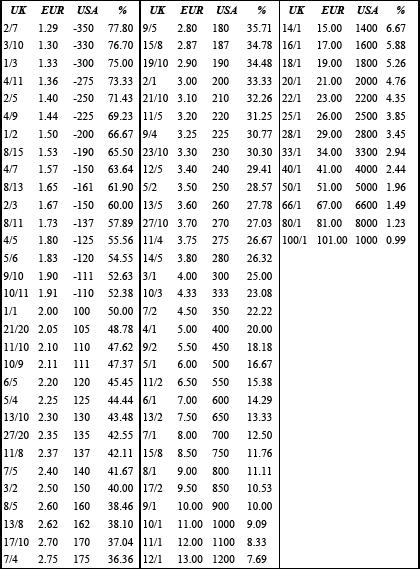
The odds relating to a coming sporting event reflect the likelihood of an outcome plus the profit to be made if your prediction turns out to be correct.
Understanding how odds work and the different ways they can be presented is important since they are fundamental in trying to assess the probability of a certain outcome.
A sporting event can have two or more outcomes depending on the situation. A tennis match, for example, is either won or lost by a player, or pair of players in a doubles match. A football match has three main choices in the win market: A team can win the match, lose the match, or draw. A horse race can involve a large number of runners so the choice for a winner is much larger. So in such cases conversely you would expect that the percentage chance of any particular horse winning is that much less. Of course these are only probabilities based on number of potential outcomes and this ignores the differing degrees of ability between horses, and it is the thrill of picking a winner and the element of chance which makes betting so exciting for many.
Thus the odds for any particular outcome of a sports event depends largely on probabilities. Now if you toss a coin we know it can only land on one of two sides, either heads or tails, so that there is a 1 in 2 chance of getting the result you want theoretically, which would be 50%, or odds of 0.50 in decimal format.
Odds for betting purposes are generally represented in one of three ways: decimal terms, as fractions, or in an American way which relates the probability to a $100 stake. In the latter case if the outcome is a positive number then it represents the amount you would win with that $100 stake. If negative then it signifies the amount you need to bet in order to win $100. The US model is little used in Europe though, and the trend here is very much towards the decimal odds system. Most betting exchanges use decimal although you can usually change the display to the fractional system should you wish. Decimal odds are easy to understand since odds of 3.0 for instance, indicates a one in three chance of winning.
With fractional odds the likelihood of an outcome is expressed as a ratio. So 3/1 odds means a one in three likelihood of that outcome occurring. However the figure for the odds is not be totally relied on when betting. It is, of course just an indication. We know that when tossing a coin the odds are 1/1 but of course you can easily have a run of either heads or tails for 5 or more throws. Similarly we know that in horse racing the favourite generally wins one third of all races, but this is only an average:
we cannot predict which third, and you could go all day without one favourite winning a race!
This is unlikely perhaps, but you certainly can go 5 or 6 races before a favourite comes in.
So we see that displayed odds are only an indication of an outcome, which is why most serious bettors study form and statistics, plus other pertinent factors before betting on a certain horse or football team rather than simply relying on the odds.
Just to illustrate the correlation between fractional and decimal odds have a look at the following: Odds of 4/1 can be worked out as 4/(4+1) which equals 0.80 and this represents an 80% chance of winning. Now odds of ¼ works out as 1(1+4) which comes to 0.20 or a 20% chance.
As well as indicating probability the odds help us calculate potential winnings on a bet. At odds of 4/1 or 5.0 in decimal form we would win £4 for each £1 staked, and the profit would be £4. In decimal odds the stake is again returned of course and is included in the payout figure. At lower odds we need to stake more to get a worthwhile return. At odds of ¼ or 1.25 for instance we would need to risk £4 in order to profit by just £1.
You can find an easy odds converter here (open in a new window).

Most people find decimal odds easier to understand and to work with which is why they are generally most popular nowadays. Decimal odds also more easily allow for small adjustments in odds whereas fractional odds would need to resort to rather unwieldy numbers.
It is quite easy to convert fractional odds to decimal, by dividing the top number by the bottom one to produce a decimal figure, and then adding 1. So 4/1 becomes 1 to which you add 1 producing odds of 5. Similarly fractional odds of 3/5 would work out as 0.6 plus 1 giving 1.6. Should you need to convert decimal odds to fractional then you need to first subtract 1 and then find the nearest whole integer, and this can be more taxing for some. However, on almost all bookmakers and exchange websites of course you can easily change all the odds shown in either format by simply clicking a button in the settings menu. There is no doubt that when viewing a page in Betfair of a horse race it is much easier to quickly comprehend a decimal odds set-up, and this is what most people choose.
There is a concept called value when it comes to the odds for a sports event. Some would say that betting at odds of less than 1.3 for example does not represent value. In other words there is too much risk for the expected gain. Certainly in tennis, as a case in point, there are plenty of times a top player with those low odds actually loses a match, as we all can have an off day occasionally. Betting at odds of less than 2 is termed “odds on betting” and some will not do this either since it would not represent good value in their opinion. It is obviously up to the individual as to what risk and what odds to accept, but understanding odds is one of the key factors in successful betting.